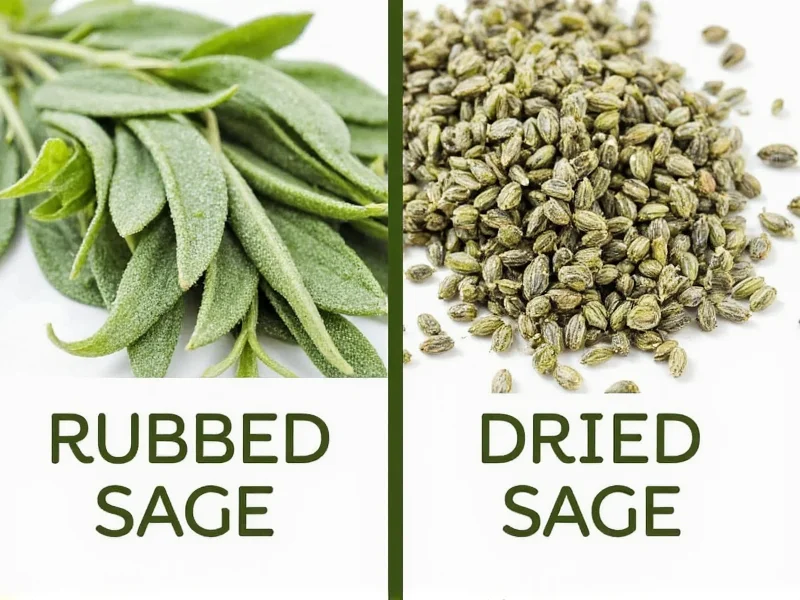Understanding the distinction between rubbed sage and dried sage is essential for home cooks and professional chefs seeking to maximize flavor in their dishes. Both forms originate from the same herb—Salvia officinalis—but their preparation methods create significant differences in culinary performance.
What Exactly Is Rubbed Sage?
Rubbed sage undergoes an additional processing step after drying. Manufacturers rub dried sage leaves through a fine sieve or screen, separating the essential oils and aromatic compounds from the fibrous leaf structure. This process creates a light, fluffy powder that contains the herb's most volatile flavor components while removing tougher plant material.
The resulting product has a distinctive dusty texture similar to fine breadcrumbs. Because the rubbing process concentrates the essential oils, rubbed sage typically delivers a more potent aroma and flavor than standard dried sage by volume. This concentrated nature makes it particularly valuable in applications where even distribution is critical.
Understanding Standard Dried Sage
Dried sage refers to the more common preparation where whole sage leaves are harvested and dehydrated without additional processing. These leaves may be sold whole, lightly crushed, or moderately crumbled, but they retain their basic leaf structure. When you purchase dried sage from most grocery stores, you're typically getting this standard preparation.
The drying process preserves sage's earthy, slightly peppery flavor profile while concentrating its natural compounds. Unlike rubbed sage, standard dried sage maintains visible leaf fragments that can be detected in finished dishes. This characteristic makes it better suited for recipes where the presence of herb pieces is acceptable or even desirable.
Comparing Key Characteristics
The differences between these two sage preparations extend beyond mere texture. Understanding these distinctions helps cooks select the appropriate form for specific culinary applications.
| Characteristic | Rubbed Sage | Standard Dried Sage |
|---|---|---|
| Texture | Light, fluffy powder with no visible leaf structure | Visible leaf fragments, ranging from whole to moderately crumbled |
| Flavor Intensity | More concentrated (use 25-30% less than dried sage) | Standard potency (1:1 measurement baseline) |
| Best Culinary Uses | Stuffings, dry rubs, sauces, and dishes requiring even distribution | Long-simmered soups, stews, and recipes where texture isn't critical |
| Shelf Life | 6-9 months (loses potency faster due to increased surface area) | 1-2 years (better retention of essential oils in intact leaves) |
| Measurement Conversion | ⅔ teaspoon rubbed sage = 1 teaspoon dried sage | 1 teaspoon dried sage = 1½ teaspoons rubbed sage |
When to Choose Rubbed Sage Over Dried Sage
Certain cooking scenarios particularly benefit from using rubbed sage rather than standard dried sage. The fine texture of rubbed sage makes it ideal for applications where you want flavor without noticeable herb particles. This includes poultry stuffing, where traditional dried sage might leave unpleasant leaf fragments, and dry meat rubs, where the even distribution enhances flavor penetration.
Rubbed sage also excels in creamy sauces and delicate dishes where the visual presence of herb pieces would be undesirable. Its concentrated flavor means you can achieve the same herbal impact with less product, which proves valuable in recipes where sage's strong flavor might otherwise dominate.
Optimal Uses for Standard Dried Sage
Standard dried sage maintains its place in many kitchen applications. Its more robust leaf structure withstands long cooking times better than rubbed sage, making it preferable for soups, stews, and braises that simmer for hours. The visible leaf fragments can also provide visual appeal in certain rustic dishes.
When making sage butter or infused oils, standard dried sage often performs better because the larger leaf pieces are easier to strain out after infusion. Additionally, dried sage works well in recipes where you want intermittent bursts of flavor from recognizable herb pieces rather than completely uniform distribution.
Storage Recommendations for Maximum Freshness
Proper storage significantly impacts the shelf life and flavor retention of both sage preparations. Store both forms in airtight containers away from heat, light, and moisture. Glass jars with tight-sealing lids work better than plastic containers, which can absorb aromatic compounds.
Rubbed sage requires more careful storage due to its increased surface area, which accelerates flavor loss. Consider dividing larger quantities into smaller portions to minimize air exposure each time you access the spice. For longest shelf life, store both forms in the refrigerator or freezer—this practice can extend their potency by several months.
Substitution Guidelines Between Sage Forms
Understanding how to substitute between rubbed sage and dried sage prevents recipe failures. When substituting rubbed sage for dried sage, use approximately ⅔ teaspoon of rubbed sage for every 1 teaspoon of dried sage called for in a recipe. Conversely, when replacing rubbed sage with dried sage, increase the amount by about 50%.
Always add sage gradually and taste as you cook, especially when substituting between forms. The flavor intensity can vary significantly between brands and harvest seasons. For the most accurate substitution in critical recipes, consider blooming the sage in a small amount of warm oil first to assess its potency before adding to your main dish.
Common Questions About Sage Preparations
Many home cooks encounter confusion when selecting between these sage preparations. Understanding these distinctions helps optimize your culinary results without wasting ingredients or compromising flavor profiles.











 浙公网安备
33010002000092号
浙公网安备
33010002000092号 浙B2-20120091-4
浙B2-20120091-4